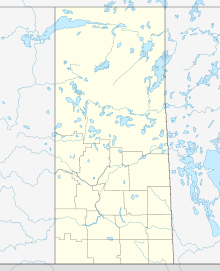Key Lake mine: Difference between revisions
JJMC89 bot (talk | contribs) Migrate {{Infobox mine}} coordinates parameters to {{Coord}}, see Wikipedia:Coordinates in infoboxes |
Rescuing 1 sources and tagging 0 as dead. #IABot (v1.3beta8) |
||
| Line 168: | Line 168: | ||
==External links== |
==External links== |
||
* {{Cite web|url=http://www.cameco.com/mining/key_lake/|publisher=Cameco Corporation|title=Key Lake}} |
* {{Cite web|url=http://www.cameco.com/mining/key_lake/ |publisher=Cameco Corporation |title=Key Lake |deadurl=yes |archiveurl=https://web.archive.org/web/20090418181037/http://www.cameco.com/mining/key_lake/ |archivedate=18 April 2009 |df= }} |
||
[[Category:Uranium mines in Canada]] |
[[Category:Uranium mines in Canada]] |
||
Revision as of 03:42, 5 May 2017
| Location | |
|---|---|
| Location | Athabasca Basin |
| Province | Saskatchewan |
| Country | Canada |
| Coordinates | 57°12′24″N 105°39′33″W / 57.20667°N 105.65917°W |
| Production | |
| Products | Uranium |
| Owner | |
| Company | Cameco(83%) and AREVA(17%) |
The Key Lake mine is a former uranium mine in Saskatchewan, Canada, and the site of the largest uranium mill in the world. It is five-hundred and seventy kilometres north of Saskatoon by air on the southern rim of the uranium-rich Athabasca Basin. Key Lake was initially developed to open-pit mine two nearby uranium ore deposits: the Gaertner deposit and the Deilmann deposit. Mining of this ore ceased in the late 1990s; the Key Lake mill now processes uranium ore from the McArthur River mine and from existing stockpiles on site. High-grade ore from McArthur river is blended with lower grade local rock before being passed through the mill. The mill has an annual production capacity of 18 million pounds of U3O8. In addition, ammonium sulfate fertilizer is produced as a byproduct from used reagents. The pits of the mined out local deposits are being used as mill tailings management facilities.
It deposits jointly remain one of the higher grade uranium deposits ever discovered, at an average grade of over 2% U3O8. Key Lake is the third largest uranium deposit in the Athabasca Basin and is surpassed only by McArthur River and Cigar Lake.
Much of the exploration and development work was carried out by Uranerz Exploration and Mining, a company linked with German utility operators.[citation needed] The ore body was discovered by tracing radioactive boulders in the overburden back to their source.[citation needed]
The nearest village by road is Pinehouse, 220 kilometres south of Key Lake.
History
| Key Lake Deposits | ||||
|---|---|---|---|---|
| Name | Discovered | Commenced | Depleted | Comments |
| Gaertner | 1975 | 1983 | 1987 | |
| Dielmann | 1976 | 1989 | 1997 | Ore stockpiled to mix with and dilute high-grade McArthur River ore. The open pit is used as a tailings management facility for McArthur River ore. |
Production
Together, between 1983 and 1997 the two Key lake deposits produced 4.08 million tonnes of ore at an average grade of 2.32% U3O8 (for a total of 208 million pounds U3O8 produced).[citation needed] The mill currently produces 18.7 million pounds of yellowcake per year.
Ownership
The Key Lake operation is owned by Cameco Corporation (83%) and AREVA Resources Canada Inc (17%), formerly COGEMA Resources Inc. Cameco is the operator.
Climate
| Climate data for Key Lake | |||||||||||||
|---|---|---|---|---|---|---|---|---|---|---|---|---|---|
| Month | Jan | Feb | Mar | Apr | May | Jun | Jul | Aug | Sep | Oct | Nov | Dec | Year |
| Record high °C (°F) | 10 (50) |
9 (48) |
12.5 (54.5) |
28.5 (83.3) |
32.5 (90.5) |
34.5 (94.1) |
33.5 (92.3) |
36 (97) |
28.5 (83.3) |
24.5 (76.1) |
12.2 (54.0) |
5 (41) |
36 (97) |
| Mean daily maximum °C (°F) | −17.7 (0.1) |
−12.5 (9.5) |
−4.5 (23.9) |
4.4 (39.9) |
13 (55) |
19.3 (66.7) |
21.8 (71.2) |
19.9 (67.8) |
12.3 (54.1) |
3.9 (39.0) |
−7.6 (18.3) |
−15.5 (4.1) |
3.1 (37.6) |
| Daily mean °C (°F) | −23.2 (−9.8) |
−18.4 (−1.1) |
−11.4 (11.5) |
−1.7 (28.9) |
6.9 (44.4) |
13.4 (56.1) |
16.1 (61.0) |
14.5 (58.1) |
7.9 (46.2) |
0.3 (32.5) |
−11.7 (10.9) |
−20.4 (−4.7) |
−2.3 (27.9) |
| Mean daily minimum °C (°F) | −28.6 (−19.5) |
−24.3 (−11.7) |
−18.2 (−0.8) |
−7.8 (18.0) |
0.7 (33.3) |
7.4 (45.3) |
10.4 (50.7) |
9 (48) |
3.4 (38.1) |
−3.3 (26.1) |
−15.6 (3.9) |
−25.3 (−13.5) |
−7.7 (18.1) |
| Record low °C (°F) | −51.5 (−60.7) |
−48 (−54) |
−50.5 (−58.9) |
−40 (−40) |
−15.5 (4.1) |
−5 (23) |
0 (32) |
−2 (28) |
−8.5 (16.7) |
−28 (−18) |
−39.5 (−39.1) |
−48 (−54) |
−51.5 (−60.7) |
| Average precipitation mm (inches) | 19.1 (0.75) |
16.7 (0.66) |
20.6 (0.81) |
26.3 (1.04) |
38.3 (1.51) |
63.2 (2.49) |
85.2 (3.35) |
68.9 (2.71) |
56.7 (2.23) |
38.4 (1.51) |
26.7 (1.05) |
21.1 (0.83) |
481.1 (18.94) |
| Source: Environment Canada[1] | |||||||||||||
Wolf attack
On New Year's Eve 2004, a lone wolf attacked a male fifty-five-year-old uranium miner named Fred Desjarlais. Desjarlais was jogging back to Key Lake's Cameco campsite when he confronted the wolf. A busload of his colleagues spotted the incident from a shuttle bus and came to his aid by frightening the wolf away. It subsequently disappeared into the wilderness. Fred received stitches when his colleagues took him to a medical facility. A few hours later, an air ambulance airlifted him to Royal University Hospital where he began a series of rabies treatments as well as recovering from his incident.[2][3]
See also
- Unconformity uranium deposits
- Uranium mining
- List of uranium mines
- Cigar Lake Mine
- Cluff Lake mine
- McArthur River uranium mine
- McClean Lake mine
- Rabbit Lake mine
References
External links
- "Key Lake". Cameco Corporation. Archived from the original on 18 April 2009.
{{cite web}}: Unknown parameter|deadurl=ignored (|url-status=suggested) (help)

